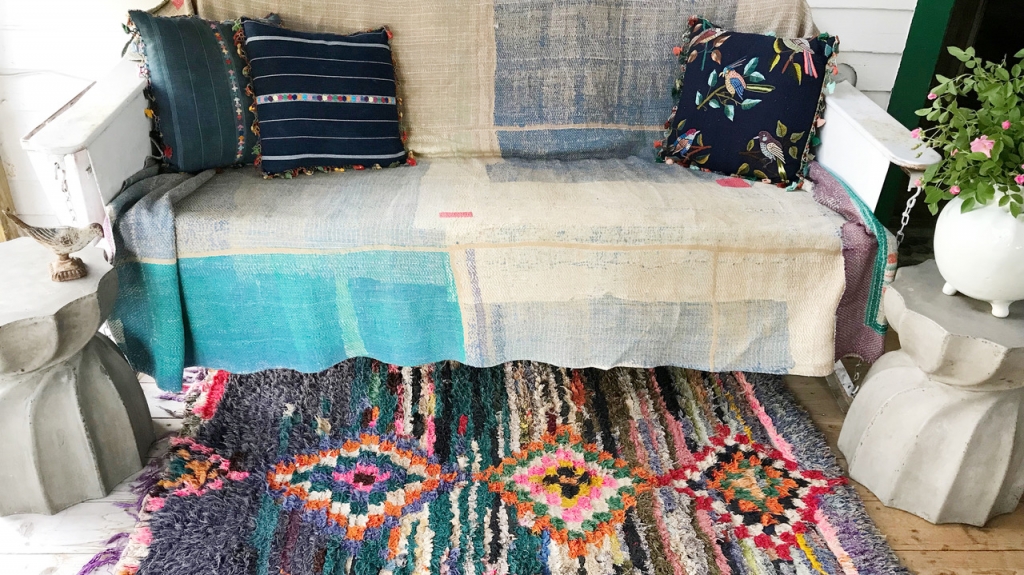
My parents bought me McCall’s Giant Golden Make-It Book when I was 8 years old. Within the pages of this beloved book, I learned to scout and gather common household materials and transform these materials into useful objects. A thin dowel with a wooden clothespin glued to the top and the opposite dowel end sunk into a small clay pot, filled with plaster of Paris, became a recipe- card-holder for my mom. Sturdy string threaded through holes punched near the base of two large upturned tomato juice cans became stilts. Soon, all the kids on my block were playing with stilts. On rainy afternoons, feeling bored, I’d thumb my way through the pages of the Make It Book, which I still possess, seeking inspiration and a project.
It’s likely that The Make-It Book shaped how later, as a textile artist, I’d assess the characteristics of common materials and wonder: what else could be made with them? I understood that almost anything could be transformed. When successful, this calculation- the sum -or finished object could be far greater than the parts -or the materials. Later still, when I traveled to Guatemala to teach rug hooking to a group of Maya women, there was never any question about the choice of materials. “Paca” was a readily available supply of used clothing. Paca arrives by the baleful from the US and is a thriving industry because it’s an inexpensive clothing option.
Mastering material and technique is one thing- you can learn this. You can learn how to handle the materials and with enough practice, you can master the technique, too. But the pieces I choose to live with bear testimony to an additional qualifier. These objects are imbued with an essential life force that comes from the soul of the maker as a conduit. It’s a mysterious force that is transferred somewhere during the process of making. This transfer can occur in even the most common everyday things. It’s in the thrown high-fire ceramic mug I drink my coffee from each morning; it’s in the twined basket that holds my keys; it’s in the carved wooden spoon I reach for to stir the soup, the spoon that still has a bit of tree bark attached, the spoon that fits my hand so well.
It’s also in the Moroccan boucheroite rug woven by an anonymous weaver. The rug where my bare feet rest as I sit reading on the glider sofa on the screened porch off the kitchen. This rug was woven and knotted from a medley of materials the weaver had on-hand: clothing bits cut into strips, string from old mop-heads, and a cache of colorful threads. To a background of calm stripes and color fields, the weaver knotted solid eye-popping checkered squares to form concentric diamonds that ‘sit’ atop the field. There’s an undeniable vitality here and the energy she left in that rug feeds me.
It’s in the story cloth by Margarita Xicon Burrion of Sumpango, Guatemala, an embroiderer participating in Multicolores* new Embroidery Project. Her spare composition is packed with a sense of quiet determination. With a revealing a glimpse into her home, she somehow transforms the paucity of the objects she owns into powerful icons of ambition: scissors, an embroidery hoop, a tape measure. Surely these icons represent the tools that fuel her way forward. Sitting up straight, upon her hard chair, she appears resolute, ready to face whatever comes next. Her piece reminds me of my purpose.
It’s in the hooked rug made by Zoila Caluga Morales, one of my Maya rug hooking students. Hands down, Zoila is the most talented woman I’ve taught anywhere. As a master weaver, from Chichicastenango, who weaves her own huipils, she possesses an intuitive sense of design. Her hooked compositions appear as if she views the world through a visionary lens. Zoila’s rug helps me see the world anew because she portrays the familiar in a way I’ve not seen before. I had heard that Zoila was going through difficult times and that she stopped hooking rugs. A year or so later I learned she was hooking again. She was hooking this rug, a rug that helped her find her way back into the world. Looking at her rug -I feel her triumph. Living with the unbridled exuberance of Zoila’s color choices and composition fills me with hope. Her rug is an emotional antidote to these troubled times.
****
Mary Anne is co-founder of www.multicolores.org, an artisan based non-profit whose hooked rugs have been included in the IFAM since 2014. Multicolores was a Community Impact Award Recipient in 2019. She is co-author, along with Cheryl Conway Daly, of Rug Money How A Group of Maya Women Changed Their Lives Through Art and Innovation, published by Thrums Books, 2018. Mary Anne is co-founder, along with Jody Slocum of www.culturalcloth.com a social enterprise representing global artisans and selling their hand-made home décor online and in their store located in Maiden Rock, Wisc, population 99 people, on the Great River Road.
Mary Anne is co-founder of www.multicolores.org, an artisan based non-profit whose hooked rugs have been included in the IFAM since 2014. Multicolores was a Community Impact Award Recipient in 2019. She is co-author, along with Cheryl Conway Daly, of Rug Money How A Group of Maya Women Changed Their Lives Through Art and Innovation, published by Thrums Books, 2018. Mary Anne is co-founder, along with Jody Slocum of www.culturalcloth.com a social enterprise representing global artisans and selling their hand-made home décor online and in their store located in Maiden Rock, Wisc, population 99 people, on the Great River Road.
